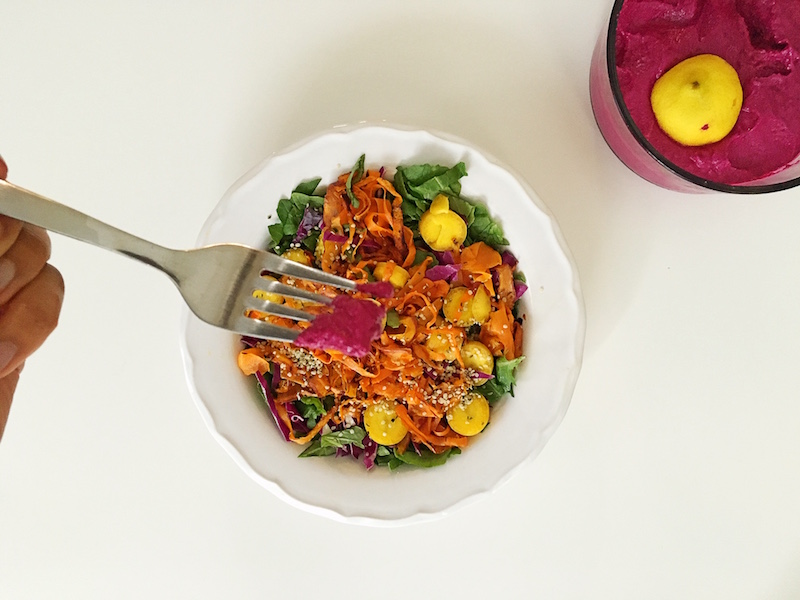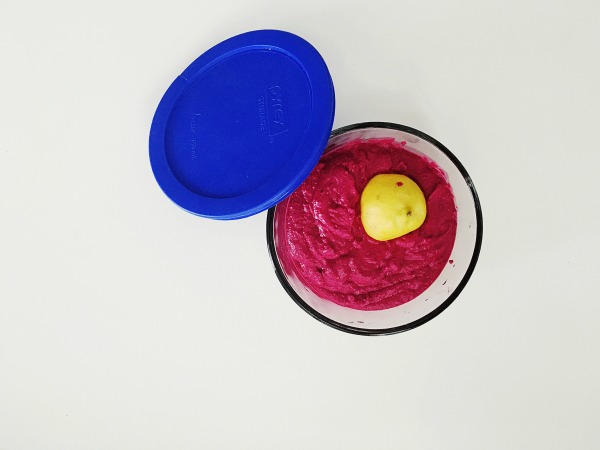I know what you’re thinking. Are you seriously going to write a recipe for a salad? Yes. I seriously am. Because I take my salads very seriously. And I really do not understand why they are so underrated as a meal. They’re either the obligatory side dish or a necessary evil in dieting hell.
WHY?
I think it’s because people are making them the wrong way.
What are you putting in your salads? Lettuce. Tomatoes. Cucumber. Ranch. Ugh. That is SO 10 years ago. Where's the color? Where's the variety? Where's the WHOLE REASON we eat salads? To give us one big dose of highly nutritious ingredients all at once. Duh!
Salads – done right – can be showstoppers. In one bite, you can have crunchy, creamy, crispy and kale-y goodness. You can bring ingredients together that normally never associate with each other – for one big party in a bowl. Mango and avocado. Kale and pomegranate. Almond butter and charred broccoli.
Saute a few carrot shreds in coconut oil, caramelize some onions in ghee, add some well-seasoned chicken, juicy ground beef or even a tin of tuna on top, and you’ve got yourself one of the best entrées on the menu, my friends. (Note: I do not mean combine all these ingredients together. That's just silly).
Becasue I am concerned for your relationship with this vital meal, today, I share with you…
The BEST salad I ever made.
No joke. Search this entire blog and I’ve never said that before because it’s a bold claim.
This baby is warm yet cool, crunchy and creamy, melts in your mouth, but with a refreshing finish. And best part, it’s SO full of nutrients. You know how I know why? Because it’s RAINBOW COLORED!
Random flashback moment:
ANYWAYS.
Where was I? Colors, right. Different nutrients give different colors to the foods they are in. And get this. It's all on purpose. Mother nature planned it that way. GENIUS!
Plants can't get up and walk around, right? So the way they literally spread their seed is by attracting animals and organisms to them with their good looks and vibrant colors. Animal likes what he sees. Animal eats. Animal hops, crawls, runs, or flies away. Animal poops out seeds somewhere else. And tada! A whole new pretty plant. So it's in their favor to stand out and look attractive.
But wait! There's more.
In addition to the pigments looking good, they also can protect the plant from UV damage, enable photosynthesis, and even act as antioxidants for the plants. The better the protection they provide, the longer they live. We humans, in turn, cash in on these benefits when we eat the plants ourselves.
Which brings me back to this beautiful salad. Let's see what we got here…
Red Cabbage
The blue tint in red cabbage (anthocyanins) –> keeps your mind sharp.
Green Kale
The deep green in kale (indoles and isothiocyanates)–> increases the production of enzymes that clear toxins from the body.
Orange Carrots and Sweet Potatoes
The orange in carrots and sweet potatoes (beta carotene) –> keeps your bones strong, your eyes healthy and boosts your immune system.
Crimson in Beets
The dark crimson in beets (Betacyanins) –> works in conjunction with vitamin C and manganese to offer benefits for eye health and overall nerve tissue health in addition to functioning as anti-inflammatory compounds.
Boom.
Forget the weird, unpronouncable words. Just eat the colors! Eat all of them. Red, orange, yellow, green blue, purple. Look out for them at the grocery store. Try weird veggies just because they're colorful. ROYGBV it up!
They're not just good for you, they're just plain GOOD.
You ready for this? I thought so.
Ingredients:
- 2 Heirloom Carrots
- 1 Small Sweet Potato
- 1-2 Tablespoons Coconut Oil
- Bowlful of Kale
- Red Cabbage, chopped
- Hemp Seeds
- 1 Tablespoon Beet Dip – See here for beet dip recipe.
Dressing Ingredients:
- 2 tablespoons Apple Cider Vinegar
- 1/4 cup Extra Virgin Olive Oil
- Salt and Pepper, to taste
Directions:
- Shred one carrot; chop the other carrot. Set aside.
- Shred the sweet potato using a vegetable peeler. Don't kill yourself trying to shred the whole thing up. Just get as far down as is comfortable and use the rest of the potato to chop up and saute later if you'd like.
- Heat coconut oil on pan and toss sweet potato shreds on. Saute until slightly crispy – 5 minutes-ish. Remove from pan to a side plate.
- Add more coconut oil to the pan and toss on carrot shreds. Saute until slightly crispy – 3 minutes-ish. Add shreds to sweet potato plate.
- Chop up kale so that it’s in nice bite-sized pieces. Put in salad bowl.
- Mix in red cabbage and chopped carrots.
- Top with sweet potato and carrot shreds.
- Scoop beet dip on top. Note, it's not TOTALLY necessary if you don't have the time to make it, but I highly recommend it. It's kind of what sends this salad over the edge. Might I suggest, too, that you just use sliced cooked beets as an addition if you don't want to make the dip.
- Sprinkle with hemp seeds.
Much Love,

P.S. Make it easy on yourself and Pin this baby!
- 2 Rainbow Carrots Also known as Heirloom Carrots
- 1 Sweet Potato
- 1-2 Tablespoons Coconut Oil
- Bowlful of Kale
- Red Cabbage chopped
- hemp seeds
- 1 tablespoon Beet Dip Optional
- 2 tablespoons Apple Cider Vinegar
- 1/4 cup extra virgin olive oil
- Sea Salt & Pepper to taste
- Shred one carrot; chop the other carrot.
- Shred the sweet potato using a vegetable peeler. Don't kill yourself trying to shred the whole thing up. Just get as far down as is comfortable and use the rest of the potato to chop up and saute later if you'd like.
- Heat coconut oil on pan and toss sweet potato shreds on. Saute until slightly crispy – 5 minutes-ish. Remove from pan to a side plate.
- Add more coconut oil to the pan and toss on carrot shreds. Saute until slightly crispy – 3 minutes-ish. Add shreds to sweet potato plate.
- Chop up kale so that it’s in nice bite-sized pieces. Put in salad bowl.
- Mix in red cabbage and chopped carrots.
- Top with sweet potato and carrot shreds.
- Scoop beet dip on top. Note, it's not TOTALLY necessary if you don't have the time to make it, but I highly recommend it. It's kind of what sends this salad over the edge. Might I suggest, too, that you just use sliced cooked beets as an addition if you don't want to make the dip.
- Sprinkle with hemp seeds.
- Pour ACV dressing on top and aggressively mix it all together.
























